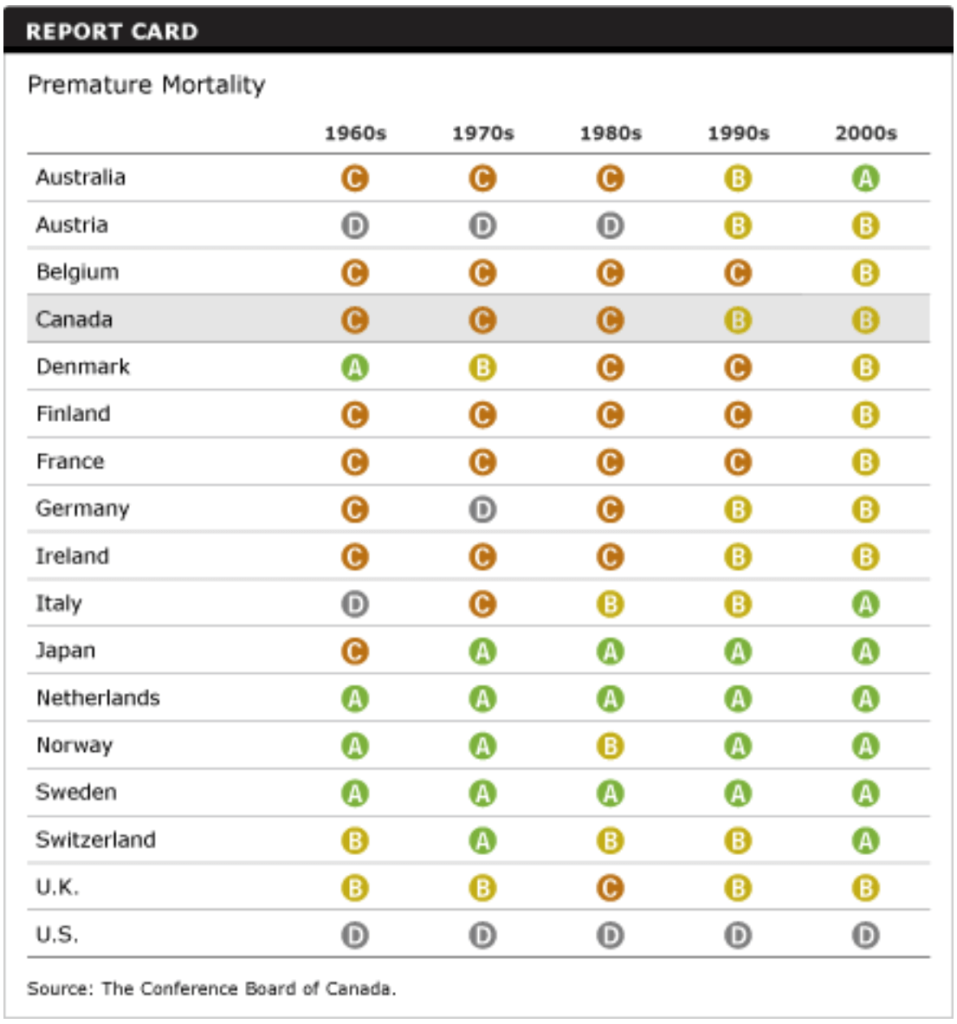Premature Mortality Rate
Key Messages
- Canada moves up in the rankings, scoring an “A” grade and ranking 9th out of 17 peer countries.
- Canada and its peer countries have all reduced their premature mortality rates over the past five decades.
- Premature death from assault in the U.S. is over four times higher than in Canada.
Putting premature mortality in context
Premature mortality is a measure of unfulfilled life expectancy. Because deaths of younger people are often preventable, the premature mortality rate is a measure that gives more weight to the death of younger people than to older people.
The premature mortality rate is calculated by multiplying the number of deaths occurring at each age by the number of remaining years of life up to a selected age limit. The Organisation for Economic Co-operation and Development (OECD)—the source of this data—makes an assumption that most people in Canada and its peer countries will live to the age of 70 (the selected age limit). If a person dies at 20, therefore, that person is considered to have lost 50 potential years of life. A person dying at age 60 has lost a potential 10 years of life. The premature mortality rate is then determined by adding up the potential lost years of individuals in each country.
By giving more weight to the death of younger people, the premature mortality indicator, along with the self-reported health status indicator, complements the life expectancy indicator, which has sometimes been criticized as placing too much importance on quantity of life and not enough on quality of life.
How does Canada rank among its peers?
Canada is now an “A” grade performer and ranks 9th among the 17 peer countries. In 2009, the number of potential years of life lost per 100,000 people in Canada and its peer countries ranged from a low of 2,458 years in Sweden to a high of 4,744 in the United States. In 2004—the most recent year of published data on the number of potential years of life lost in Canada—there was a premature mortality rate of 3,365 years of life lost per 100,000 population in Canada. In 2009, Canada’s estimated premature mortality rate dropped to 2,999 years of life lost per 100,000 population.1
Most countries perform well compared with the U.S., the only “D” performer on this indicator. One-third of the premature mortality rate in the U.S. can be attributed to deaths resulting from external causes, including accidents, suicides, and assaults. Premature death from assault in the U.S. is over four times higher than in Canada.2
Has Canada reduced its premature mortality rate?
Canada’s premature mortality rate has shown progressive improvement over the past four decades—the rate in 1960 was over three times the 2009 estimated rate. Annually, Canada’s premature mortality rate has decreased by an average of 127 years.
Japan recorded the most improvement, however, reducing its premature mortality rate by an average of 193 years annually since 1960. The Netherlands—with an annual reduction of 80 years—saw the least improvement.
Has Canada’s relative performance improved?

Although Canada has reduced its premature mortality rate consistently over time, most of its peer countries have also seen steady improvement. There has thus been only marginal change in the relative rankings.
In the 1960s, Canada’s incidence of premature mortality earned it a “C” grade; for the 1990s and 2000s, Canada has earned a “B” average.
The Netherlands and Sweden have maintained their “A” grades for five decades. The U.S. has been a consistently poor “D” performer.
Footnotes
1 Missing data up to 2009 for peer countries were obtained by projecting the most recent year of data using a 10-year average annual growth rate.
2 Organisation for Economic Co-operation and Development, OECD Health Data 2011.

